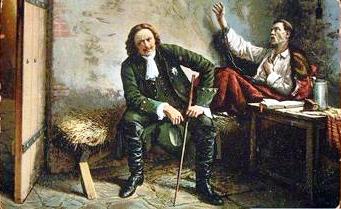Vasily Volkov on:
[Wikipedia]
[Google]
[Amazon]
Vasily Alekseyevich Volkov (Russian: Василий Алексеевич Волков; 21 March 1840,
 From 1858 to 1863, he studied at the
From 1858 to 1863, he studied at the
@ Art.ru In 1867, he was awarded the title of "Artist" (Third degree). From 1875 until his death, he taught drawing at the school. He also occasionally taught at the local
@ Ozmns.narod Most of the reproductions were apparently made from a copy.
Postcards
@ Delcampe (artist misidentified as Valentin Volkov) {{DEFAULTSORT:Volkov, Vasily 1840 births 1907 deaths 19th-century painters from the Russian Empire Russian male painters Russian portrait painters Painters from Saint Petersburg History painters Peredvizhniki Painters from the Russian Empire 19th-century male artists from the Russian Empire
Saint Petersburg
Saint Petersburg ( rus, links=no, Санкт-Петербург, a=Ru-Sankt Peterburg Leningrad Petrograd Piter.ogg, r=Sankt-Peterburg, p=ˈsankt pʲɪtʲɪrˈburk), formerly known as Petrograd (1914–1924) and later Leningrad (1924–1991), i ...
– 22 April 1907, Poltava
Poltava (, ; uk, Полтава ) is a city located on the Vorskla River in central Ukraine. It is the capital city of the Poltava Oblast (province) and of the surrounding Poltava Raion (district) of the oblast. Poltava is administratively ...
) was a Russian-Ukrainian Academic
An academy (Attic Greek: Ἀκαδήμεια; Koine Greek Ἀκαδημία) is an institution of secondary education, secondary or tertiary education, tertiary higher education, higher learning (and generally also research or honorary membershi ...
painter; known primarily for portraits and historical scenes.
Biography
 From 1858 to 1863, he studied at the
From 1858 to 1863, he studied at the Imperial Academy of Fine Arts
The Russian Academy of Arts, informally known as the Saint Petersburg Academy of Arts, was an art academy in Saint Petersburg, founded in 1757 by the founder of the Imperial Moscow University Ivan Shuvalov under the name ''Academy of the Thre ...
. From 1861, he was also a teacher at a local gymnasium. After graduating, he settled in Poltava.Brief biography@ Art.ru In 1867, he was awarded the title of "Artist" (Third degree). From 1875 until his death, he taught drawing at the school. He also occasionally taught at the local
Institute for Noble Maidens
An Institute for Noble Maidens () was a type of educational institution and finishing school in late Imperial Russia. It was devised by Ivan Betskoy as a female-only institution for girls of noble origin. Those were "Closed female institutes of th ...
.
During this time, he also operated his own art school and exhibited with the Peredvizhniki
Peredvizhniki ( rus, Передви́жники, , pʲɪrʲɪˈdvʲiʐnʲɪkʲɪ), often called The Wanderers or The Itinerants in English, were a group of Russian realist artists who formed an artists' cooperative in protest of academic restr ...
, although he never became a member. He apparently served as a State Councillor
A state councillor () is a high-ranking position within the State Council, the executive organ of the Chinese government (comparable to a cabinet). It ranks immediately below the Vice-Premiers and above the ministers of various departments. Si ...
.
In 1907, he died of cardiac asthma
Cardiac asthma is the medical condition of intermittent wheezing, coughing, and shortness of breath that is associated with underlying congestive heart failure (CHF). Symptoms of cardiac asthma are related to the heart's inability to effectively an ...
.
Among his best-known portraits are those of Tsars Alexander II and Alexander III, Grand Duke Konstantin Konstantinovich and his fellow painters, Nikolai Yaroshenko
Nikolai Alexandrovich Yaroshenko (russian: Николай Александрович Ярошенко; uk, Микола Олександрович Ярошенко; – ) was a Russian Imperial painter of Ukrainian origin.
Yaroshenko painte ...
and Leonid Pozen. However, he is largely remembered today on the basis of one work.
In 1901 his painting, "Peter the Great
Peter I ( – ), most commonly known as Peter the Great,) or Pyotr Alekséyevich ( rus, Пётр Алексе́евич, p=ˈpʲɵtr ɐlʲɪˈksʲejɪvʲɪtɕ, , group=pron was a Russian monarch who ruled the Tsardom of Russia from t ...
Visiting Pavlo Polubotok
Pavlo Polubotok ( uk, Павло Леонтійович Полуботок, russian: Павел Леонтьевич Полуботок, pl, Paweł Połubotok; born around 1660, died on 29 December 1724), was a Ukrainian Cossack political and mili ...
at Peter and Paul Fortress
The Peter and Paul Fortress is the original citadel of St. Petersburg, Russia, founded by Peter the Great in 1703 and built to Domenico Trezzini's designs from 1706 to 1740 as a star fortress. Between the first half of the 1700s and early 1920s i ...
in 1724" was presented by the Peredvizhniki in Moscow. Peter died 41 days after visiting Polubotok, who ominously forecast that "Soon, very soon, the judgment of God will judge Peter and Paul!".
Public response to the painting was immediate and positive. It was praised in '' Niva'' and several other periodicals, including ' (Sparks), a satirical magazine. The exhibition catalog sold out and the painting was reproduced as postcards; black and white, color prints and hand-painted versions (which are valuable collectors' items).
The current whereabouts of the original are unknown. It is said that Volkov sold it to a visiting Englishman not long after it was exhibited, but there is no record of it being taxed or having left the country; something that was usually documented very meticulously."Mirror of Fate"@ Ozmns.narod Most of the reproductions were apparently made from a copy.
References
External links
Postcards
@ Delcampe (artist misidentified as Valentin Volkov) {{DEFAULTSORT:Volkov, Vasily 1840 births 1907 deaths 19th-century painters from the Russian Empire Russian male painters Russian portrait painters Painters from Saint Petersburg History painters Peredvizhniki Painters from the Russian Empire 19th-century male artists from the Russian Empire